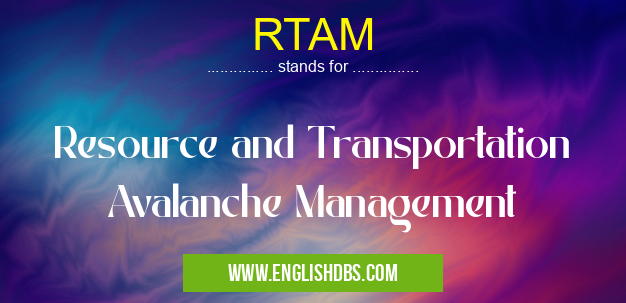What does RTAM mean in MANAGEMENT
RTAM stands for Resource and Transportation Avalanche Management. It's a specialized field that focuses on assessing, managing, and mitigating the risks associated with avalanches in transportation corridors.

RTAM meaning in Management in Business
RTAM mostly used in an acronym Management in Category Business that means Resource and Transportation Avalanche Management
Shorthand: RTAM,
Full Form: Resource and Transportation Avalanche Management
For more information of "Resource and Transportation Avalanche Management", see the section below.
» Business » Management
RTAM: A Comprehensive Explanation
RTAM plays a vital role in ensuring the safety of transportation systems by implementing various measures:
-
Assessment: Conducting thorough evaluations to identify avalanche-prone areas and determine their potential impact on transportation routes.
-
Analyzing historical avalanche data
-
Conducting field surveys and deploying sensors
-
Management: Developing and implementing strategies to reduce the likelihood and severity of avalanches.
-
Installing avalanche barriers and diversion structures
-
Enforcing traffic closures during high-risk periods
-
Mitigation: Implementing measures to protect transportation infrastructure and travelers from avalanches.
-
Relocating roads and railways away from avalanche zones
-
Constructing snow sheds and tunnels
Benefits of RTAM
RTAM offers significant benefits to transportation operations:
- Enhanced Safety: Reduces the risk of avalanches and improves the safety of transportation corridors.
- Reliability: Ensures consistent and reliable transportation services by minimizing disruptions caused by avalanches.
- Economic Impact: Protects transportation infrastructure and reduces potential damage and repair costs.
Essential Questions and Answers on Resource and Transportation Avalanche Management in "BUSINESS»MANAGEMENT"
What is RTAM (Resource and Transportation Avalanche Management)?
RTAM is a comprehensive approach to managing avalanche risk in transportation corridors, encompassing mitigation, forecasting, and emergency response.
What are the key aspects of RTAM?
RTAM involves identifying and assessing avalanche hazards, implementing mitigation measures, establishing forecasting systems, and developing emergency response plans.
How does RTAM contribute to transportation safety?
RTAM reduces the risk of avalanches by actively managing hazards and improving preparedness. It ensures safe and reliable transportation of people and goods through avalanche-prone areas.
What are examples of RTAM mitigation measures?
Mitigation measures include avalanche barriers, snow sheds, avalanche forecasting and warning systems, and controlled blasting.
Who is responsible for RTAM?
RTAM typically involves collaboration between transportation agencies, avalanche experts, and emergency responders.
How does RTAM address the potential for climate change impacts on avalanche risk?
RTAM considers the potential for changing weather patterns and snowpack conditions due to climate change. It includes measures to adapt and adjust mitigation strategies accordingly.
What are the benefits of implementing RTAM?
RTAM enhances transportation safety, reduces downtime caused by avalanches, and protects infrastructure and property.
Final Words: RTAM is an indispensable component of transportation safety, providing a systematic approach to managing avalanche risks. By implementing comprehensive assessment, management, and mitigation strategies, RTAM safeguards transportation systems and travelers alike.
